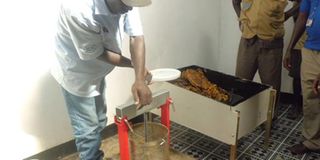Napak farmers earn from beekeeping

Extracting honey from the combs at the plant in Apeitolim. Right, group members at one of their apiary sites. PHOTO BY LOMINDA AFEDRARU
While most farmers in Uganda concentrate on growing crops, rearing animals and keeping poultry, a good number are realising the commercial potential of apiculture, the deliberate keeping of bees for honey and other products.
In Napak District, especially those in Apeitolim, the farmers are convinced that beekeeping is a manageable farming activity in this part of the country due to its climate and plant cover.
Starting out
The area is endowed with natural flowering plants, which enhance the quality of the honey. Although a source of water is a big challenge, the farmers have been able to establish small dams near sites where the bee hives are set up.
Also, the farmers have formed an association known as Apeitolim Agro Pastoral Field School comprising five sites, each with 30 members.
Tonny Francis Egau, coordinator of the group, says the farmers picking interest in modern beekeeping was an initiative from a local non-governmental organisation, Community Management Watershed Development Organisation (Comwo), which was supported by funding from the European Union.
Equipped with skills
Comwo conducted a sensitisation of the farmers about the best practices of modern bee keeping. Then, there was formation of associations for purposes of carrying out collective production, followed by training, processing and marketing of the packaged honey.
The farmers were equipped with skills in quality control, harvesting, processing and handling of equipment as well as spotting places to establish apiaries.
It is important to note that apiaries are set either under a big tree or a thicket of forested natural trees, where there is source of water and where there is no noise.
Getting the gear
They were taught how to use smokers and harvesting gear, and to guard against using fire, which kills the bees.
Each site was provided with a set of smokers, harvesting gears, and Kenya Top Bar (KTB) bee hives.
Those members based in Apeitolim trading centre, where the processing factory is also situated, have a total of 150 KTB bee hives in two separate sites and the rest have 50 KTB bee hives.
According to Egau, since farmers started this initiative last year, they have harvested three times. Each bee hive contains 10 kg of honey on average. The honey is processed at the mini factory and packaged in 500 gram bottles, which are sold at Shs6,000 each.
Since November last year, the group in Apeitolim trading centre has sold honey worth Shs1.7m, which will be shared among the members. Each member will decide what to do with his or her money.
The chairperson, Mariko Lachoro, said the group members are encouraged to own local bee hives individually from which they can bring honey for processing at the association’s plant at a subsidised fee.
Exploring other products
Currently, the processed honey is sold at local markets in Soroti, Kotido, Moroto and Katakwi. Most customers like it because it is not adulterated. Since this is a new farming activity for the members, their future plan is to collect proceeds from the sales which they intend to save and eventually lend to other farmers in form of loans which will be paid back with interest.
These farmers are sometimes faced with the challenge of pests such as birds, beetles and ants, which destroy the combs although this is not yet rampant.
While like those in Apeitolim, most beekeepers in the country mostly focus on apiary products such as honey and beeswax, which is used in making candles, there are other products like jelly, pollen and venom, which can also be exploited.
standards for honey
The international buyers for Uganda’s honey are in Europe especially in UK, Germany and The Netherlands. They are large in size and order equally large quantities; they set standards on moisture and sugar content and determine a host of tests to be subjected to the honey.
Uganda National Bureau of Standards has put in place the specifications, which provides a framework for quality assurance and control of all Uganda honeys.
The moisture content should not be more than 20 per cent, sugars such as fructose and glucose should not be more 60 per cent and it should be free of metals, pesticides and drug residues.




